Neither the over-hyped dream team of the Central government, the kleptocracies of state capitals, nor the subsidies- addicted great Indian middle class, seems interested in paying more than ritual obeisance to the cause of primary education, particularly of the huge mass of children of the poor. Dilip Thakore reports
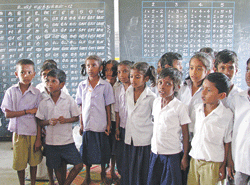 The latest edition of Elementary Education in India — Progress towards UEE (Universal Elementary Education) 2006-07, published by the Delhi-based National University of Educational Planning and Administration (NUEPA) in late August, is unlikely to offer more than a few crumbs of comfort to the small minority of sentient individuals who believe that formative, high quality elementary education (primary and upper primary K-VIII) for all of India’s 253 million children in the age group five-14, is the prerequisite of national development. Neither the over-hyped dream team of the Central government, the kleptocracies of state capitals, nor the nation’s subsidies-addicted great Indian middle class — obsessed with caste-based reservations and quotas in over-subsidised institutions of higher education — seem interested in paying more than ritual obeisance to the cause of primary education, particularly of the huge mass of children of the poor at the base of India’s iniquitous social pyramid.
The latest edition of Elementary Education in India — Progress towards UEE (Universal Elementary Education) 2006-07, published by the Delhi-based National University of Educational Planning and Administration (NUEPA) in late August, is unlikely to offer more than a few crumbs of comfort to the small minority of sentient individuals who believe that formative, high quality elementary education (primary and upper primary K-VIII) for all of India’s 253 million children in the age group five-14, is the prerequisite of national development. Neither the over-hyped dream team of the Central government, the kleptocracies of state capitals, nor the nation’s subsidies-addicted great Indian middle class — obsessed with caste-based reservations and quotas in over-subsidised institutions of higher education — seem interested in paying more than ritual obeisance to the cause of primary education, particularly of the huge mass of children of the poor at the base of India’s iniquitous social pyramid.
Of course, politically correct lip service is routinely paid to the importance of primary education. India was an enthusiastic signatory to the Millennium Declaration of the year 2000, which set out the millennium development goals (MDGs), one of which is all children enrolled in primary school by the year 2015 — in pursuance of which the Union government rolled out its Sarva Shiksha Abhiyaan (SSA or Education for All) programme in 2001.
Moreover last month after years of prevarication, the Union cabinet finalised the long-awaited Right to Education Bill 2008 which makes it mandatory for the State (Central, state and/or local governments) to provide free and compulsory education to all children in the age group six-14. The Bill is scheduled to be tabled in Parliament during its current winter session, but given the proclivity of this august institution to be adjourned for days on end because of protests and disruptions, proponents of the Bill are apprehensive about its passage in this last session of the present Parliament.
Yet even if it is passed, the diluted Bill, which is vague on vital issues —division of fiscal responsibility between the Central and state governments; the culpability of parents and government for out-of-school children; ensuring provision of acceptable quality education in government schools —and imposes a legally doubtful 25 percent quota of poor neighbourhood children upon private unaided schools, is unlikely to transform the country’s dismal elementary education scenario to any meaningful degree.
Indeed it’s becoming increasingly clear that the SSA programme rolled out by the previous BJP-led NDA (National Democratic Alliance) government, whose hamfisted Union HRD minister Dr. Murli Manohar Joshi foolhardily advanced the date for realisation of the MDGs to the year 2010, has not proved effective in meeting the grave challenges confronting primary and upper primary education in India. Although SSA and the world’s largest school mid-day meal programme, which now covers 120 million children, has improved primary enrollment numbers and percentages, learning outcomes in government-run rural primaries have plunged precipitously. The Annual Status of Education Report 2007, published by the Mumbai-based NGO Pratham, whose 20,000 volunteers conduct an annual survey of the quality of education being dispensed in 587 rural districts across the country, reveals that learning outcomes in government-run rural primaries, increasingly being staffed with under-qualified ‘para-teachers’ are abysmal. It found that class V children are unable to exhibit the reading, writing and arithmetic skills they should have acquired in class II.
And it’s an indicator of the national conspiracy of silence and massive cover-up of the mess in primary/elementary education that although a detailed labour of love and statistically invaluable, the recently released EEI 2006-07 is editorially silent, and conspicuously refrains from interpreting the wealth of data it offers to the public. Thus in his foreword to EEI, Prof. Ved Prakash, vice-chancellor of NUEPA, restricts himself to praising the university’s capability in developing its “computerised educational manage-ment information system” christened DISE (district information system for education).
.gif) “I am happy to note that the process that was initiated in 42 states across seven DPEP (district primary education programme) Phase-I states in 1994-95, has been expanded to all 35 states and Union territories of the country. The database generated through DISE has been significantly contributing towards strengthening evidence-based decen-tralised planning and monitoring of primary and upper primary education at the district and sub-district levels,” says Ved Prakash. Despite the grandiose title of NUEPA, which was accorded university status in August 2007, there’s no comment about the major conclusions of EEI 2006-07.
“I am happy to note that the process that was initiated in 42 states across seven DPEP (district primary education programme) Phase-I states in 1994-95, has been expanded to all 35 states and Union territories of the country. The database generated through DISE has been significantly contributing towards strengthening evidence-based decen-tralised planning and monitoring of primary and upper primary education at the district and sub-district levels,” says Ved Prakash. Despite the grandiose title of NUEPA, which was accorded university status in August 2007, there’s no comment about the major conclusions of EEI 2006-07.
Likewise Prof. Arun C. Mehta, author of EEI 2006-07, is also content to underscore the wonders of the DISE software system. “The highlight of the report is that information on every school is available at the click of a mouse. Otherwise there is no material difference between this and last year’s report, though there is some improvement in all indicators as visible from the statistical data compiled,” he informed EducationWorld’s Delhi-based correspondent Autar Nehru.
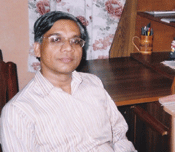 Nevertheless despite taking care to give credit for marginal “improvement(s) in all indicators” to government, Mehta admits that the high percentage of students — “30 percent in primary and 40-45 percent in upper primary” — dropping out of school is “a major challenge”. “The achievement report of NCERT (National Council for Education Research and Training) and Pratham’s ASER data have highlighted poor learning outcomes, but things are improving. Government is aware; it is adding classrooms and teachers, but these initiatives take time to translate into action,” explained Mehta to EW’s Nehru. This apologia is typical of Indian academics excessively tolerant of glaring government failure to reform the primary education system dominated by the country’s 1.20 million government primaries and upper primaries, which provide deplorable foundational education to over two-thirds of the nation’s 179.34 million primary school children.
Nevertheless despite taking care to give credit for marginal “improvement(s) in all indicators” to government, Mehta admits that the high percentage of students — “30 percent in primary and 40-45 percent in upper primary” — dropping out of school is “a major challenge”. “The achievement report of NCERT (National Council for Education Research and Training) and Pratham’s ASER data have highlighted poor learning outcomes, but things are improving. Government is aware; it is adding classrooms and teachers, but these initiatives take time to translate into action,” explained Mehta to EW’s Nehru. This apologia is typical of Indian academics excessively tolerant of glaring government failure to reform the primary education system dominated by the country’s 1.20 million government primaries and upper primaries, which provide deplorable foundational education to over two-thirds of the nation’s 179.34 million primary school children.
Therefore it’s hardly surprising that while EEI 2006-07 provides a wealth of statistical data, which highlights the rot and neglect in State-dominated primary education more than half a century after detailed Soviet-style central planning and government micro-management of the education system was imposed upon the country, the eight-page Executive Summary of the report begins by noting that the number of schools in India has increased from 1.12 million in 2005-06 to 1.19 million in 2006-07, of which 87.15 percent (1.04 million) are in rural India. More pertinently, the number of primary schools has increased from 601,866 to 779,842 — a handsome 29.5 percent over the year.
EEI 2006-07’s executive summary attributes this surge in the number of schools to the Central government’s Sarva Shiksha Abhiyan initiative inaugurated in 2001. But somewhat confusingly, in a passing reference it also provides the nugget of information that “category-wise distribution (sic) of schools reveals that the majority of the (new) schools (65.14 percent) are independent primary schools”. Deciphered, this statement buried without comment in the executive summary, suggests that private initiatives driven by public demand for quality primary education (which government primaries are unable to provide), are behind the surge in elementary education countrywide.
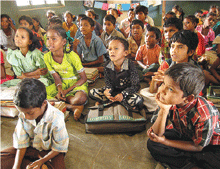 Moreover deriving unwarranted comfort from data indicating that the ratio of upper primary schools/sections to primary institutions has dropped from 2.68 in 2004-05 to 2.45 in 2006-07, the EEI executive summary states: “Many of the states have the ratio equivalent of almost two, all of which suggests that by and large schooling facilities have been created and are available across the country.”
Moreover deriving unwarranted comfort from data indicating that the ratio of upper primary schools/sections to primary institutions has dropped from 2.68 in 2004-05 to 2.45 in 2006-07, the EEI executive summary states: “Many of the states have the ratio equivalent of almost two, all of which suggests that by and large schooling facilities have been created and are available across the country.”
This casual complacency about a massive shortage of upper primaries is intriguing. Common sense dictates that the ratio of primary to upper primary schools should be 1:1, if the millennium development goal of all children completing primary education is to be attained. Although the authors of EEI 2006-07 don’t say so, this innocuous statistic explains the huge number of over 90 million (53 percent) of the 179 million children in primary school, dropping out before entering upper primary education (classes VI-VIII). The bald truth is that there just aren’t enough upper primaries to accommodate them! Therefore the assertion of the authors of EEI 2006-07 that “by and large schooling facilities have been created and are available across the country”, is misleading, and is likely to induce unwarranted complacency within government and the public.
Such white-washing of government and societal failure to make sufficient provision for the nation’s 450 million (below age 18) child population, and drawing misleading conclusions presumably on the principle of discerning the half glass full than half empty, EEI 2006-07 paints a gloss over a plethora of depressing statistics testifying to grave neglect of elementary education in 21st century India. For instance, the report seems to be content with noting that between 1994-95 and 2006-07, 258,780 primary schools were promoted — equivalent to 33.20 percent of the total number of primaries countrywide. And with a touch of triumphalism it notes that “about 91 percent of such schools have been provided school buildings”. The fact that almost 25,000 primaries have been established across the country without the basic facility of a school building is a matter of little consequence to the authors of EEI 2006-07.
Likewise in the chapter titled ‘facility indicators’, the authors of the explanatory executive summary note with satisfaction that “more than 85 percent” of schools offer the facility of drinking water to students, up from 83 percent in 2004-05. The reality that over 150,000 (mainly state-run) schools across the country don’t offer the basic facility of drinking water to their students, doesn’t stir the conscience of the authors of EEI 2006-07. Similarly the authors of the study seem satisfied that 58 percent of schools now have common toilets for boys and girls as opposed to a mere 42 percent in 2003-04, with 43 percent offering the facility of separate toilets for girl children (28 percent). Yet the national disgrace of over 500,000 schools without toilets at all, and 684,000 without separate facilities for girl children (a major causative factor of India’s massive female illiteracy of 40 percent), does not provoke any comment in EEI 2006-07.
.gif) Such benign tolerance of official neglect of primary education was recently excoriated by Dr. Krishna Kumar, the Cambridge-educated director of the National Council for Education Research and Training, who taking umbrage at a casual remark made by India’s top scientist Dr. C.N.R Rao to the effect that establishing a new IIT (Indian Institute of Technology) is not as easy as setting up a primary school, lashed out at the education establishment through the columns of the Times of India.
Such benign tolerance of official neglect of primary education was recently excoriated by Dr. Krishna Kumar, the Cambridge-educated director of the National Council for Education Research and Training, who taking umbrage at a casual remark made by India’s top scientist Dr. C.N.R Rao to the effect that establishing a new IIT (Indian Institute of Technology) is not as easy as setting up a primary school, lashed out at the education establishment through the columns of the Times of India.
“The pejorative reference Rao made to primary schools is not just offensive to those of us who serve children in our formal capacities; it also reveals a huge mental block in the minds of India’s highest-level development planners. The idea that primary schools can be established and run cheaply has been central to educational planning since independence. The idyllic myth of the village school master under a tree (has) persisted for several decades after independence,” wrote Krishna Kumar in an op-ed piece in which he called for “making (primary) education compulsory and improving school quality” (ToI November 20).
Greater awareness that attracting children to primary school and retaining them there, requires substantial investment in infrastructure and teacher training, is beginning to seep down to educationists across the country. “Enrollment trends in primary and upper primary schools in Tamil Nadu and India as a whole, have been encouraging over the past five years. However higher enrollment per se isn’t a sufficient condition for attaining the UEE (universal elementary education) goal. Retention of children in primary school and high transition from primary to upper primaries is an essential requirement. This isn’t possible without greater infrastructure investment in elementary education. Although EEI 2006-07 reports that all schools in Tamil Nadu have school buildings, micro level studies indicate that a significant number of schools run by local governments are functioning in dilapidated buildings, under thatched roofs and under trees even in this educationally forward state, which is ranked third in NUEPA’s Education Development Index,” says Dr. S. Ananthalakshmi, the Chennai-based honorary director of the information, documentation and research centre of the Indian Council for Child Welfare, Tamil Nadu.
Larger outlays for the country’s 779,482 primary and upper primary schools as a pre-condition of attracting and retaining the massive cohort of an estimated 160 million children who should be in school but are not, has been consistently advocated by EducationWorld during the past nine years since it was promoted in 1999. But alas, to little avail, with the education establishment in New Delhi and the states giving the cold shoulder to this publication, despite its nationwide readership of 700,000 plus.
Nevertheless last April (2008), following presentation of the Union budget 2008-09 in which typically grudging provision was made for primary education (the 2 percent education cess levied on all direct tax payers was merged with the Central government’s modest provision for education to show a 20 percent higher outlay of Rs.34,400 crore), EducationWorld presented a blueprint of a supplementary primary education booster budget. With the aid and advice of Dr. A.S. Seetharamu, hitherto professor of education at the Institute for Social & Economic Change, Bangalore, the EW supplementary budget provided a template to equip every primary school countrywide with a laboratory, library and toilet block (see box p.74).
Although ex facie the one-time expenditure of Rs.47,725 crore proposed by EW seems a huge amount, as highlighted in our unprecedented cover feature, it aggregates a mere 1 percent of GDP — requiring a modest addition to the 3.5 percent of GDP that government (Centre plus states) have provided for education for the past four decades, despite the Kothari Comm-ission having strongly recommended an annual outlay of 6 percent of GDP way back in 1966. Yet such is the indifference of the establishment and the middle class (which shuns the public education system and patronises the country’s 146,000 private schools) towards meaningful education for children of the poor and underprivileged, that neither Union finance minister P. Chidambaram, nor the public, exhibited any enthusiasm for EW’s booster budget proposal.
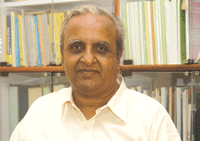 Comments Dr. Seetharamu, who lived laborious days drawing up this publication’s lab-lib-lav supplementary budget (EW April 2008), and is currently an education advisor to the Karnataka state government: “The plain truth is that official and middle class apathy towards universal primary education rooted in elitist indifference, is a long-standing phenomenon. Neither politicians nor the middle class, focused upon qualifying their children as engineers, doctors, lawyers and MBAs, are interested in good primary education for the masses, because non-literate people tend to be humble, submissive and non-questioning. With literacy, citizens acquire self-respect and self-assertion which doesn’t suit the establishment. That’s why the first and second Education Commissions constituted in 1948 and 1952 focused their attention on the tertiary and secondary education sectors. The low status accorded to public primary education reflects the national mindset and official priorities which favour investment in power, water and public works sectors, which offer greater scope for skimming and kickbacks.”
Comments Dr. Seetharamu, who lived laborious days drawing up this publication’s lab-lib-lav supplementary budget (EW April 2008), and is currently an education advisor to the Karnataka state government: “The plain truth is that official and middle class apathy towards universal primary education rooted in elitist indifference, is a long-standing phenomenon. Neither politicians nor the middle class, focused upon qualifying their children as engineers, doctors, lawyers and MBAs, are interested in good primary education for the masses, because non-literate people tend to be humble, submissive and non-questioning. With literacy, citizens acquire self-respect and self-assertion which doesn’t suit the establishment. That’s why the first and second Education Commissions constituted in 1948 and 1952 focused their attention on the tertiary and secondary education sectors. The low status accorded to public primary education reflects the national mindset and official priorities which favour investment in power, water and public works sectors, which offer greater scope for skimming and kickbacks.”
Nor is Seetharamu bitter or disheartened that his lab-lib-lav study has not evoked any reaction from the government or public. “Government and the bureaucracy will never acknowledge or commend a good idea. Nevertheless EW’s study suggesting ways and means to establish lab-lib-lav units in every primary school has impacted official thinking. Governments across the country have become sensitive to the issue of adequate sanitation and hygiene in education institutions, and circulars have gone out recommending student-toilet ratios in primary-secondary schools. There’s no doubt in my mind that there is new awareness and serious thinking about infrastructure provision in education ministries across the country, because the neglect of primary education is increasingly being regarded as moral corruption and breach of faith by the Central and state governments,” he says.
The shameful apathy of government and the great Indian middle class towards the public primary education system is not merely an issue of moral corruption, as argued by Dr. Seetharamu. Both the establishment and public seem determined to turn a blind eye to the open, continuous and uninterrupted financial corruption which bedevils the public elementary education system.
A June 2008 service study focused mainly upon rural BPL (below poverty line) households, conducted by the Delhi-based Transparency International India (TII) and Centre for Media Studies (CMS), measures degrees of corruption in 11 selected public services including primary education. It indicates that over 700,000 poorest of poor BPL households were obliged to pay bribes aggregating Rs.12 crore in 2007, to avail of government schooling which is legally free of charge to citizens. “A majority of those who paid bribes did so for getting their children admitted into school, or for getting promotion of their children from one class or another, or to obtain school-leaving certificates,” say the authors of the study.
Yet the demand for bribes from the poor and socially disadvantaged is only the tip of the massive iceberg of corruption, which is dragging down the nation’s school system in which, as EEI reiterates, “the percentage of government and government-aided schools is as high as 86.63 which shows that nine out of every ten schools imparting elementary education in the country are funded by government”. The authors of the TII-CMS India Corruption Study 2007 take pains to stress that: “The present study focuses only on the bribe(s) paid by BPL households at the contact point and does not include corrupt practices prevalent in the school education system like in the appointment of teachers, construction of school buildings, procurement and diversion of mid-day meals.”
Nor does the TII-CMS study beam a searchlight over major scandals such as chronic teacher truancy (1.25 million government school teachers countrywide are absent from duty on any given day), and the thrusting of shoddy vernacular language textbooks upon children obliged for reasons of parental poverty, to attend state and local government-run primaries (see ‘India’s unchecked textbooks racket’, EW January 2005).
|
Anti-corruption prescription
In a devastating indictment of the government (state and local)-run school K-12 system, a TII-CMS India Corruption Study 2007, jointly conducted by Delhi-based NGOs Transparency International India (TII) and Centre for Media Studies (CMS), says that over 700,000 or 40 percent of BPL (below poverty line) households countrywide were obliged to pay bribes for availing free of charge government schooling for their children. The study indicates that the amount paid by BPL — poorest of poor — households for theoretically free school services was Rs.12 crore last year. The survey/study also made several suggestions for improving government school services to eliminate corruption. Among them:
• Procedure for new admission certificates should be made more transparent by involving Village Education Committees (VECs) in the process
• Improved infrastructure such as provision of upper primary and secondary level schools with conducive teaching-learning environments in the proximity of BPL neighbourhoods will provide better educational opportunities to poor households and check corruption
• Selection of scholarship students should be done in consultation with gram panchayats. Official discretion in selection should be minimised
• VECs should monitor the functioning of schools and keep the local community informed about their right to education, and protest corruption
• Social audit of schools should be conducted once in two-three years
• Representation of BPL households in Parent Teacher Associations and VECs should be encouraged
• With private schools expanding their operations in many states, public-private partnership schools should be encouraged
• The need for repeat visits to schools for admission and documents should be reduced by simplifying procedures
Source: TII-CMS India Corruption Study 2007
|
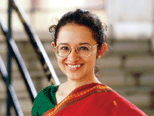 “Thorough reform of the government primary school system is required with more accountability to local parent bodies, better governance and application of the basic principles of institutional management. Serious examination also needs to be given to the proposal to give cash vouchers to parents, to let them freely choose schools for their children, because intermediaries tend to appropriate a major share of the benefit in all public goods delivery systems,” says Dr. Ashima Goyal, an alumnus of Bombay University and Delhi School of Economics and currently professor of economics at the Indira Gandhi Institute of Development and Research, Mumbai.
“Thorough reform of the government primary school system is required with more accountability to local parent bodies, better governance and application of the basic principles of institutional management. Serious examination also needs to be given to the proposal to give cash vouchers to parents, to let them freely choose schools for their children, because intermediaries tend to appropriate a major share of the benefit in all public goods delivery systems,” says Dr. Ashima Goyal, an alumnus of Bombay University and Delhi School of Economics and currently professor of economics at the Indira Gandhi Institute of Development and Research, Mumbai.
As the term in office of the Congress-led 17-party United Progressive Alliance government, which has ruled the nation since 2004, is drawing to a close, it’s amply clear that its dream team of economists including prime minister Manmohan Singh, has missed a great opportunity to set Indian education — particularly foundational primary education — right.
Despite the unprecedented inflow of tax receipts as a consequence of annual rates of 8 percent GDP growth, the government has conspicuously failed — as EEI 2006-07 graphically illustrates — to invest sufficiently in the development of India’s abundant and high-potential human capital. Instead the UPA’s massive tax windfall has been frittered away in conspicuous government consumption, populist handouts and untargeted subsidies. Even the long-pending Right to Education Bill 2008 (which makes it mandatory for the State to provide free and compulsory education to all children in the age group six-14) which has been drafted and redrafted since 2003, and has recently been approved by the Union cabinet, seems unlikely to be passed in the final session of this Parliament.
Yet a more equitable order in Indian education requires not just political will, but also the pressure of public opinion, to eliminate the inherent injustice, fraud and corruption which are embedded in the country’s government-dominated elementary education system.
Download Universal lab-lib-lav calculcus: userfiles/file/p-72.pdf
With Autar Nehru (Delhi) & Hemalatha Raghupathi (Chennai)